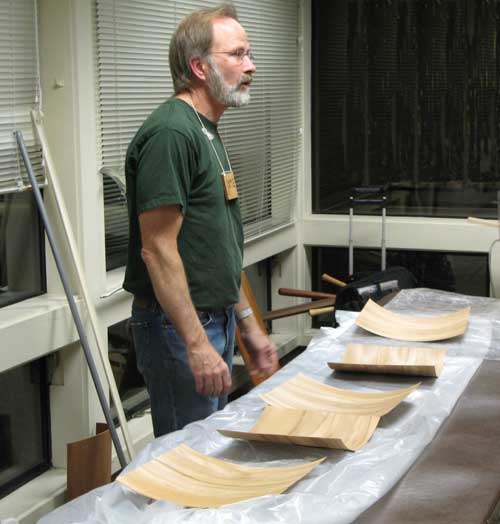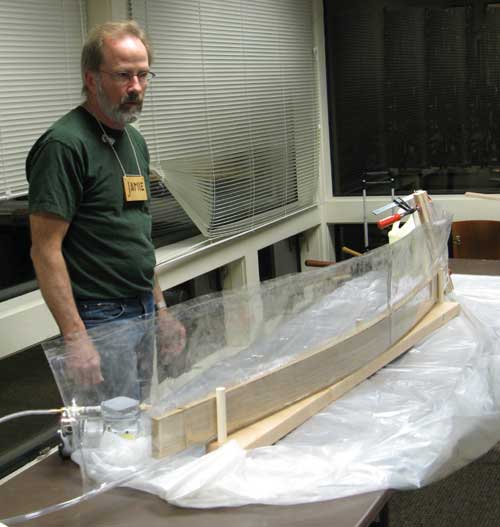
Last meeting
![]()
In the absence of our past President Bill Henzel, our Vice President Jay Perrine formally presented the President's gavel to our new President, Frank Ramsay.
Frank called for any new guests to identify themselves. Carol Salvin of Oakland builds furniture and Van Bagley of Oakland introduced themselves. They had found us on the web. We also had 3 new members. Jason Crouch of San Mateo joined as did Mark Jones of Morgan Hill. Phil Wenger of Greenbrae who makes small boxes and furniture was not able to attend. A warm welcome was given to all and we hope that the new members will learn and also teach us in the field of woodworking.
In the absence of Stan Booker, our Rafflemeister who is in Africa distributing tools to deserving wood schools, Arnie Champagne ably stepped into the role. He showed a fine board of Bird's Eye Maple for the raffle. He told us how it could be sliced to make some fine matched veneers. He almost sold enough tickets to raffle it off the same night. Remember, $1/ticket or 6 for $5.
The presenter at the February meeting was our own Jamie Buxton. His presentation was vacuum bag forming of bent laminations and molded plywood. He showed the two items he was going to demonstrate: a bent lamination which might be the apron on a bowfront table, and a molded plywood piece which he used on a purse he showed at a BAWA meeting last year. The bent lamination had three layers bandsawn from one plank, and would be bent on a form which was outside the vacuum bag. The molded plywood was made of five layers of commercial sliced veneer. It would be molded around a bending form which was inside the vacuum bag.
First, Jamie talked about some of the tools and glues that he uses. He did the demonstration with yellow glue (PVA) so that pieces could come out of the bag during the meeting. However, he does not use PVA for real laminations because of the allegations about creep. He uses urea formaldehyde glue for real work. The brand he uses is Unibond 800, available from www.vacupress.com. Urea formaldehyde has an open time of hours, which can be a big benefit in complicated glue-ups, and it doesn't have the creep issue of PVA. Urea formaldehyde won't set up in temperature under 55 degrees. One solution is to use an electric blanket. Another urea formaldehyde brand is DAP/Weldwood's Plastic Resin glue. As to Gorilla glue, some of his tests showed that it is not as strong as the other glues. It also foams and expands as it dries. To spread the glue, there are several methods. One is a paint roller which is disposable. Another is a steel or plastic trowel with a serrated edge. For small projects, he uses and later demonstrated a credit card and made a serrated edge by touching it to his saw. His vacuum bags are shop-built from 20-mil clear vinyl. Vinyl cement is used to seal the edges and one end. The sheet vinyl and cement can be purchased locally at Tap Plastics. To exhaust the bag, a hole is made in one edge and a vinyl tube is glued in. The tube inside the bag is punched with holes. The open end of the bag is closed by folding it back upon itself, and clamping it with a couple of boards. He also showed a no-clamps closure device made from plastic pipe.
He then showed two examples of bending forms. The bending form can be either inside the vacuum bag or outside. Using it inside the bag, the vacuum actually bends the wood to the shape of the mold and presses the laminates together. Using the outside the bag approach, the laminates are slathered with glue, bent into the form required, placed into the bag and the vacuum presses the laminates together. As to spring back, he said the more laminates used, the less spring back there will be.
Using the yellow glue for the demonstration, he took the square pieces of veneer and spread them out and then started spreading glue using the serrated credit card. The glue was spread very uniformly only on one side and a somewhat thin layer. The pieces were then assembled and placed on the bending form and placed in the bag. The vacuum pump then sucked all the air out of the bag, and squeezed the laminate stack tightly to the bending form.

The second demonstration, involved the long pieces of lumber. He spread them out and again spread the yellow glue only on one side. He slid the stack into a vacuum bag, and then bent the bag-plus-wood over a bending form which was outside the bag. The vacuum pump then clamped the laminates tightly together while the bending form established the curve.

He brought some examples of finished pieces --- a chair with a bent-laminated "spine", and a curved plywood cabinet door. The door was ¾" thick, so using sliced veneer for the laminates was out. Instead, he used bending plywood. Bending plywood has different characteristics from standard plywood, and is specifically designed for this sort of work. MacBeath and PALS carry it under the name Italian bending poplar. While the glue was drying in the bags, the meeting went on to other matters.
Complete vacuum presses are available from Woodcraft, Woodworker's Supply, Vacupress, and others. If you want to build your own, www.joewoodworker.com sells parts.
Thank you, Jamie. An excellent presentation.
Jay Perrine talked about a new program for the club to try. That is to have a Quarterly Saw Dust Session. This would not be a structured type of activity but to allow a group of people to get together and work on a project. Some ideas were to make a box (remember the box contest later on this year) or a tool box or something else. The first Saw Dust session is tentatively scheduled for Saturday, March 15th from 10 AM to 12 Noon at The Saw Dust Shop, 452 Oakmead Dr., Sunnyvale, 408 992-1004. Member Craig Colvin kindly let us use his space. All the tools there (believe me there are many) will be available for the group to use. You will be free to stay and use the tools after the activity but then there will be a charge. More information will be coming out soon.
Harold Patterson, our Toy Workshop guru talked about another session in April. He is looking to have toy rocking horses made. Also, he would like to make toys for girls and this is where everyone's thinking caps should come on to figure out a project(s). He is also thinking about drawing up a set of plans and then have you, the members make certain parts and then have the toy put together later in the year.
Excellent Teacher Arnie Champagne showed some boards with top veneers and edge band veneer. He described how he uses clamps and cauls to glue the veneer to the boards.
Claude Godcharles brought some jigs he made to sharpen turning tools. He built a table for his grinding wheels with a slot under each wheel. Into the slot, he can slide a wooden arm at the end of which, he built a very sturdy adjustable table (platform). This is what he uses to sharpen his scrapers. The table edge is very close to the grinding wheel so that the end of the scraper is fully supported. On rounded scrapers, he can rotate the scraper to sharpen. I have a metal platform which I bought and Claude's is 3 times more stable. For a roughing gouge which needs only to be rotated to sharpen, he has a holder for the tool end on an arm and by sliding the arm closer or further away from the wheel to get the proper angle, he can sharpen. For a spindle or bowl gouge which has 3 facets, he made a tool holder which at its end has a point. He slides the gouge into the tool holder then places the tool holder point into the cup at the end of the sliding arm. He slides the tool sliding arm in or out to get the proper angle for the facet, he can then rotate the tool to sharpen all 3 facets. There are many such tool holders on the market but his seemed better made and more adjustable. He also has jigs to maintain the angles for the facets so setting the sliding arm is automatic even as the wheel wears away and changes diameter. Thank you Claude, an excellent presentation. Draw up the designs and share them with us.
The meeting concluded with the giving out the door prizes which were sheets of veneer provided by Arnie Champagne. Of course, your unfortunate Newsletter Editor again won nothing. Members shuffled off into the darkness dreaming of building a vacuum bag big enough to hold the 7-foot high armoire they will soon be building.
Mark Rand